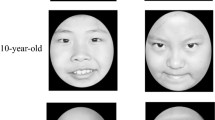Abstract
The assumption of differential socialization experiences lead to the hypothesis that African American children would be less stereotyped in their responses to infants than White American children. This study of fifty-three 8–10-year-old children from African American and White American working-to-middle class families supported the hypothesis. The children were photographed with a peer, an infant, and with an infant while acting as a parent. All children stood significantly closer to the infant in the role condition and exhibited more attraction behavior. As predicted, gender differences were evident between White girls and boys, but not between African American girls and boys. Findings suggested that social preferences for infants cannot be necessarily linked to gender. Discussion of the findings from earlier study with younger children (Reid et al., 1989) supported this conclusion.
Similar content being viewed by others

References
Berman, P. W. (1980). Are women more responsive than men to the young? A review of developmental and situational variables. Psychological Bulletin, 88, 668–695.
Berman, P. W., & Goodman, V. (1984). Age and sex differences in children's responses to babies: Effects of adults' caretaking requests and instructions. Child Development, 55, 1071–1077.
Berman, P. W., Smith, V. L., & Goodman, V. (1983). Development of sex differences in response to an infant and to the caretaker role. Journal of Genetic Psychology, 143, 283–284.
Berman, P. W., Goodman, V., Sloan, V. L., & Fernander, L. (1978). Preference for infants among Black and White children: Sex and age differences. Child Development, 49, 917–919.
Blackwell, J. E (1985). The black community: Diversity and unity. Second Edition. New York: Harper & Row.
Edwards, C. P. (1991). Behavioral sex differences in children of diverse cultures: The case of nurturance to infants. In M. Pereira & L. Fairbans (Eds.), Juveniles—Comparative socioecology. New York: Oxford University Press.
Elliott, G. C. (1982). Self-esteem and self-presentation among the young as a function of age and gender. Journal of Youth and Adolescence, 11, 135–153.
Feldman, S. S, Nash, S. C., & Cutrona, C. (1977). The influence of age and sex on responsiveness to babies. Developmental Psychology, 13, 675–676.
Goffman, E. (1959). The presentation of self in everyday life. Garden City, NY: Doubleday.
Goffman, E. (1979). Gender advertisements. Cambridge, MA: Harvard University Press.
Ladner, J. (1971). Tomorrow's tomorrow. Garden City, NY: Doubleday.
Lightfoot, S. L. (1978). Socialization and education of young black girls in schools. Conference on the educational and occupational needs of black women. Volume 1. Washington, DC: National Institute of Education.
Mack, D. (1974). The power relationship in black families and white families. Journal of Personality and Social Psychology, 30, 409–413.
Monroe, Shimmin, & Monroe (1984). Gender understanding and sex role preference in four cultures. Developmental Psychology, 20, 673–682.
Nash, S. C., & Feldman, S. S. (1980). Responsiveness to babies: Life-situation specific sex differences in adulthood. Sex Roles, 6, 751–758.
Reid, P. T. (1979). Racial stereotyping on television: A comparison of behavior of both black and white television characters. Journal of Applied Psychology, 64, 465–471.
Reid, P. T. (1981). Socialization in Black female children. In P. W. Berman & E. Rames (Eds.), Women: A developmental perspective. Washington, DC: NIMH.
Reid, P. T., Tate, C. S., & Berman, P. W. (1989). Preschool children's self-presentations in situations with infants: Effects of sex and race. Child Development, 60, 710–715.
Romer, N., & Cherry, D. (1980). Ethnic and social class differences in children's sex-role concepts. Sex Roles, 6, 245–263.
Rosenberg, F. R., & Simmons, R. G. (1975). Sex differences in the self-concept in adolescence. Sex Roles, 1, 147–159.
Whiting, B. B., & Edwards, C. P. (1988). Children of different worlds: The formation of social behavior. Cambridge, MA: Harvard University Press.
Wilson, M., Tolson, T. F. J., Kiernan, M., & Hinton, I. D. (1990). Flexibility and sharing of child-care duties in nontraditional black families. Sex Roles, 20, 000–000.
Author information
Authors and Affiliations
Additional information
We gratefully acknowledge Carol S. Tate for her assistance in data collection and analysis, and Jeannie M. Shook for coding. This research was supported in part by a faculty research grant given to the first author by the University of Chattanooga Foundation (R04-106830)
Rights and permissions
About this article
Cite this article
Reid, P.T., Trotter, K.H. Children's self-presentations with infants: Gender and ethnic comparisons. Sex Roles 29, 171–181 (1993). https://doi.org/10.1007/BF00289934
Issue Date:
DOI: https://doi.org/10.1007/BF00289934



